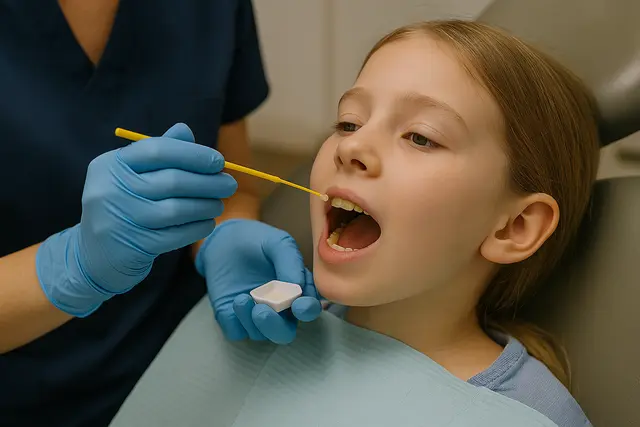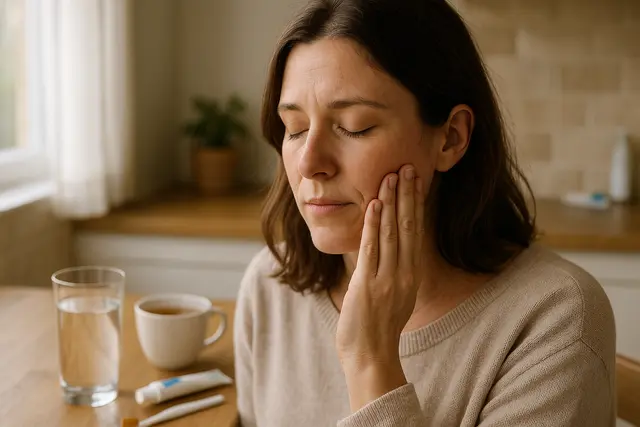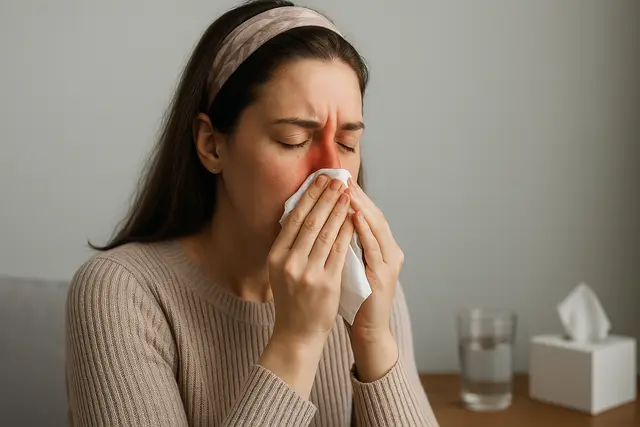General Dentistry
3 min read
May 23, 2025
How Long to Leave Fluoride Varnish on Teeth for Best Results
Just had a fluoride treatment and not sure what to do next? You’re not alone. A lot of people leave the dentist’s office wondering how long that sticky varnish needs to stay on, and what happens if you mess with it too soon.

So, you just got a fluoride treatment at the dentist, and now you’re wondering if you can eat, drink, brush, or do anything without messing it up. Totally fair. Nobody wants to sit through a dental appointment just to rinse it all away with a latte five minutes later.
Let’s talk about what really matters: how long you should leave fluoride varnish on your teeth for it to actually work, and how to avoid wasting that visit.
First, What Exactly Is Fluoride Varnish?
Think of it as a thin, sticky armor painted onto your teeth. Your dentist applies it during a routine cleaning to help prevent cavities and protect enamel from acid attacks. It’s quick, it’s painless, and it works quietly in the background, if you give it the time it needs.
The varnish isn’t like a mouth rinse you spit out. It’s meant to stay on your teeth for a few hours so the fluoride can soak into the enamel and help strengthen weak spots before tooth decay shows up uninvited.
So, How Long Should Fluoride Varnish Stay on Your Teeth?
For best results, you’ll want to leave it on for at least 4 to 6 hours. That’s the sweet spot most dentists agree on. Some recommend keeping it on even longer, until bedtime, if possible. It depends a bit on the brand your dentist used and how your mouth responds, but either way, longer is better.
You don’t need to walk around worried about it. It hardens quickly with your saliva and forms a protective layer that clings to your teeth while it works. The key is just to give it time before brushing or eating anything that might strip it away.
Can You Eat or Drink After Fluoride Treatment?
Yes, but not right away. Wait at least 30 minutes before eating or drinking anything, and even then, skip the hot stuff. No coffee, no soup, no acidic drinks like orange juice. Hot or acidic foods can soften or dissolve the varnish before it does its job.
Go for soft, bland, room-temperature foods if you’re hungry. Think applesauce, yogurt, mashed potatoes, anything gentle. The goal is to let the varnish stay on your teeth without interference.
Also, no brushing or flossing for at least 4–6 hours. Seriously. That means don’t brush your teeth, don’t floss, and definitely don’t scrape at it with your fingernail if it feels a little weird. That varnish is supposed to be there.
Why Bother With Fluoride Varnish at All?
Because it works. Fluoride varnish can help strengthen enamel, slow down early signs of tooth decay, and even reverse the beginning stages of a cavity. It’s one of the easiest, most effective treatments in dentistry.
If you have sensitive teeth, gum recession, a history of cavities, or just want to stay ahead of tooth problems, fluoride varnish is a solid move. It’s part of preventive care, and unlike a filling or root canal, it doesn’t hurt or break the bank.
What to Expect After Fluoride Treatment
Your teeth might feel a little waxy or coated for a few hours. That’s normal. It’s the varnish doing its thing. It will gradually wear off on its own, especially once you brush and floss again later in the day or the next morning.
Just remember: no aggressive brushing, no whitening toothpaste, and nothing gritty or acidic right away. Let the fluoride absorb. That’s what makes it an effective treatment.
Still Unsure What to Do?
If you’ve got questions about fluoride varnish, don’t just Google and guess, call your local dentist. They'll walk you through the timing and help tailor a plan that makes sense for your teeth, whether you’re at high risk for cavities or just trying to stay on top of dental hygiene.
The short version? Leave the varnish on for 4 to 6 hours, avoid certain foods, and don’t brush too soon. That’s it. A small effort now can give you longer-lasting protection and stronger teeth down the road.
Want healthy teeth for the long haul? This is one of the easiest ways to start.
How Long Should Fluoride Varnish Stay on Your Teeth?
Fluoride varnish should stay on your teeth for at least 4 to 6 hours to allow proper absorption into the enamel. Some dentists recommend leaving it on until bedtime for maximum benefit. During this time, avoid brushing or flossing to let the fluoride do its job.
Can You Eat or Drink After Getting Fluoride Treatment?
Yes, but you should wait at least 30 minutes before eating or drinking anything, and avoid hot or acidic foods and drinks like coffee or orange juice. Stick to soft, bland foods at room temperature to avoid disturbing the varnish before it fully sets.
Why Should You Get Fluoride Varnish?
Fluoride varnish helps strengthen enamel, prevent cavities, and even reverse early signs of decay. It’s a painless, cost-effective preventive treatment that’s especially helpful for people with sensitive teeth, a history of cavities, or enamel erosion.
What Should You Avoid After Fluoride Varnish Is Applied?
Avoid brushing, flossing, or eating abrasive or acidic foods for at least 4 to 6 hours after treatment. This ensures the varnish stays in place and gives the fluoride time to soak into the enamel for maximum cavity protection.
Read Next
Related Posts

General Dentistry
How to Stop Nerve Pain in Tooth: Fast Relief That Works
Tooth nerve pain can be one of the most intense and disruptive types of discomfort. It often strikes without warning and makes everyday activities like eating, drinking, or even talking feel unbearable. Understanding what causes this pain and how to manage it effectively is key to getting fast relief.
4 min read
Sep 15, 2025

General Dentistry
Can a Sinus Infection Make Your Jaw Hurt? Understanding the Connection
Jaw pain can be unsettling, especially when it seems to appear out of nowhere alongside a stuffy nose or headache. Many people are surprised to learn that sinus infections can cause discomfort that feels like it’s coming from the jaw. Understanding the connection between your sinuses and jaw pain is key to getting the right treatment.
5 min read
Sep 15, 2025

General Dentistry
What Is SRP in Dentistry? A Complete Guide to Scaling and Root Planing
When it comes to dental health, most people think regular cleanings are enough to keep their smile safe. But sometimes, what’s happening below the gumline needs more attention. Scaling and root planing (SRP) is a treatment designed to address gum disease at its source, protecting both your gums and teeth from long-term damage.
5 min read
Sep 10, 2025
Don’t have time to research every dentist around you?
See why 30k+ patients trusted us